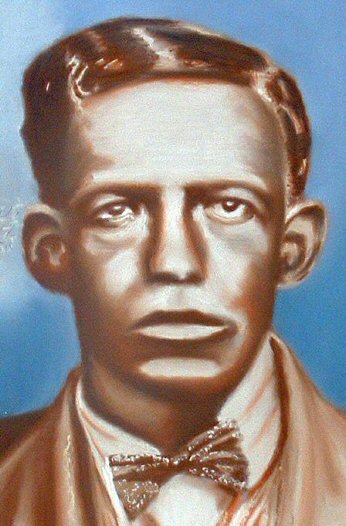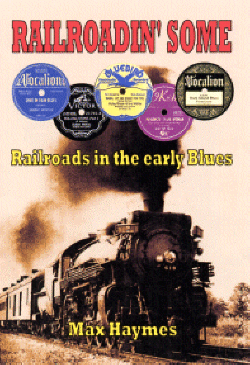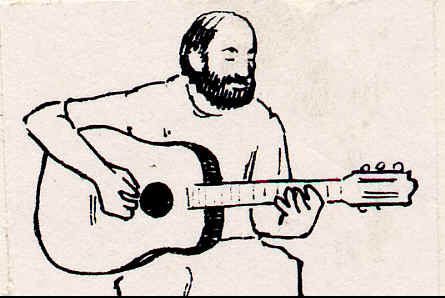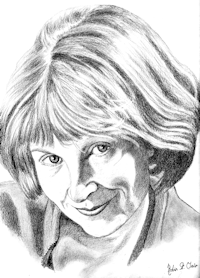
Painting © 2004 Loz
Arkle
Website
© Copyright 2000-2011 Alan White - All
Rights Reserved
Site optimised for Microsoft Internet Explorer
Poetry and The Blues |
|
DEFINITIONS 'Poem' is from the Greek 'poiema' meaning something made or created and thereby a work of art. The Oxford English Dictionary (OED) defines a poem as
The OED however does not go on to explain what it means by 'ordinary prose' and we must turn to the Penguin Dictionary of Literary Terms for a more satisfactory definition:
It is this 'magic' that characterises poetry and is summed up by A E Houseman who said that he recognised good poetry if it made his beard stubble tingle. The Oxford English Dictionary's description of 'the blues' is rather lame:
and blues music is defined as:
Once again, we need to turn from academic sources to the experience of those who lived the blues, just as others lived poetry. Peter Guralnick points out that it is a lot easier to keep on saying what blues is not but that 'in the end you come back to familiar conundrum; if you have to ask, well then you're just not going to understand. Because blues after all is little more than a feeling' (1). Son House elaborated on this in his 'The Jinx Blues':
Victoria Spivey said that 'the blues is life and life is the blues. It covers from the first cry of a newborn to the last gasp of a dying man. It is the very existence'. The blues defies neat categorisation because it was (as Paul Oliver puts it) an essential part of the black experience of living. The blues originally started in the late 19th century as an emotional release for the black slaves to try and cope with the appalling conditions in which they were living. It was a spontaneous outpouring of their innermost feelings with the emphasis upon the vocal element rather than any instrumental backing. However, as with all generalisations there are exceptions and the carefully crafted work of, for example Robert Johnson, blurs any neat distinctions between poetry and blues. In 'Woman With Guitar' Paul and Beth Garon discuss Memphis Minnie's poetry at great length and in a such a way as to ensure that Memphis Minnie herself would probably not recognise her work. To say that Minnie's songs can be arranged
is to force interpretations upon her work that were never intended. The majority of blues artists (like Shakespeare and other early dramatists) wrote and sang for an immediate public and not for academic analysis many years later. Blues music is the experience of a particular people and culture living through a specific time and set of conditions. We can interpret our experience in the light of that music, but those lyrics should not be transposed to another time and place. Son House emphasised the transient nature of lyrics when he insisted that it didn't matter what he sang on the record since the record was only a brief moment in a song that was always in the process of continual change,
It is clear then that a number of both similarities and differences are apparent in blues and poetry. Both defy neat definition yet one is a carefully nurtured creation on any subject and the other is the spontaneous outpouring of personal experience. An examination of lyrics in the light of specific poetic techniques may help to clarify the links between the two. POETIC TECHNIQUES IN THE BLUES If, as most critics agree, poetry must rise above the level of ordinary prose, the usual method of doing this would be to employ one or more linguistic techniques such as imagery, personification, form, rhyme and multi layers of meaning. One of the devices usually associated with poetry is imagery and blues lyrics have a distinctive treatment of images. Relatively few images appear in the blues and the ornate images internationally associated with poems, especially those about relationships, never appear. However the images that are used are particularly powerful, partly because of their rarity and partly because of their raw earthiness.
It is common for a blues song to open with an image and then to abandon that image and complete the song realistically, as in the opening verse of Kokomo Arnold's 'Milk Cow Blues'
Images are also frequently used in an attempt to define the indefinable - the blues. In particular, it is often personified in an attempt to show the complex adversary/companion concept of the blues:
Because so much of the blues is about relationships many images are inevitably sexual allusions and the images used are often from everyday working life and are very rarely from nature or nature's moods. Many metaphors and similes are from the railroad ('she shaped like a Cannonball'(2)) or from food
However there are also some images in the blues worthy of even the severest poetic critic's admiration, such as in the haunting lyrics of Ida Cox's 'Coffin Blues' or Blind Lemon Jefferson's 'See That My Grave Is Kept Clean'
One of the masters of blues images however (and one of the typical exceptions to every generalisation) must be Robert Johnson. His work often continues an image throughout and the images that he chooses are those that would appeal to his audience but are also sufficiently removed from the realities of everyday life to ensure that a mystique and emotional intensity is preserved. 'Me and The Devil Blues' is typical of the devil imagery for which he is best remembered (despite it only making up 25% of his recorded output) and the final image of his evil spirit roaming the world in a Greyhound bus must rank as one of the greatest modern poetic images and would be a worthy successor to the poetry of Marlowe's 'Dr Faustus'. Johnson is an exception however and generally there are few images associated with blues music and those that are tend to be drawn from colloquial speech and everyday life. If blues lyrics are to be raised above the level of prose, then it is not achieved by imagery alone. A second device traditionally associated with poetry is rhythm and particularly rhyme. Fortunately, twentieth century poetry has successfully rejected the notion that all poetry must rhyme and even that it needs to have a certain metre or beat. However this reveals an important distinction between poetry and the blues. Blues songs were intended to be sung as entertainment, not printed and academically analysed and therefore to sacrifice logic for rhythm is less of a problem in the blues than it is in a poem. It is likely that those blues which do have a definite rhyme scheme were not the spontaneous creations of the traditional non-sequential (almost nonsensical at times) blues. Those blues songs with a definite rhyme scheme often use it for comic effect as in 'G Burns Is Gonna Rise Again' by Johnson, Nelson and Porkchop:
A third technique used by both poets and blues singers is to embrace several layers of meanings in a work. This concept is fundamental to blues songs and probably derives from the plantation times when they could not openly protest about their conditions and could only vent their anger and misery by singing about it in a veiled way. This could be achieved through the tune as for example in the traditional 'Shortnin Bread' which was sung with a lively vigorous tune but the words were negative and sorrowful ('heel's cracked open like shortnin' bread'). Multiple meanings are frequently found in a song's content as in Barefoot Bill's 'Bad Boy'. The song appears as an apology for his crimes until the very last line:
Instead of the expected 'sin' he uses 'sing, thereby implying that his sorrow is because he has been cowed into giving up singing and not because he repents his crimes. This last line in 'Bad Boy' demonstrates a further poetic device described by John Donne as 'the end crowns the work'. He believed that a poem is an intellectual exercise, that any section of it cannot be understood in isolation and the final verse or line is often the lynch-pin. Again this points to a fundamental difference between conventional poetry and the blues. The blues are traditionally non-sequential, spontaneous emotional outpourings (as in Henry Thomas's 'The Fox and The Hounds') and are not necessarily governed by a planned narrative in which a single idea is developed in order to come to fruition in the last line. Many thousands of books and articles have been written about the formal structure of a poem and the sheer number of these texts point to the fact that there is no accepted definitive structure or structures. The blues have their own devices of form and these have as much right to claim poetic device status as the classical formats used by Milton or Spenser. A typical blues form is to repeat a line and this was traditionally done to give the singer time to think of another line. Floating verses and lines are also frequently found in blues music such as
However this device does divide blues from poetry. Whilst acknowledging that everything in life is derived from something else, a poet would attempt to create an original work whereas a blues singer would use these floating lines or verses as being an essential part of the tradition he/she was working in. GENERAL COMPARISONS BETWEEN POETRY AND THE BLUES In addition to the linguistic devices associated with poetry there are a number of other considerations when comparing blues with poetry. Firstly, blues lyrics cannot be divorced from the song. Songs differ from poetry in that the success of the former is usually dependent upon the singer - his/her voice, charisma, etc. Poetry must be able to stand alone, on a printed page. It is worth remembering too the Greek derivative of 'poetry' which implies that a poem is a work of art. Art could be broadly defined as a carefully crafted, deliberate creation and the 17th century poet John Donne alluded to this when he spoke of a 'good' poem as resembling 'a well wrought urn'. Blues songs are entertainment in a way that most poetry will never be. Blues and poetry do coincide however in the way that they both speak for their audience. The American Salvatore Quadimodo (1901-1968) made the following comment about poetry but it could equally be applied to the blues:
Blues singers are more aware of their traditional role as spokesperson for the black community than this quotation suggests but nevertheless they are the medium for expressing this universal feeling. Many blues songs are about a few central themes (e.g. relationships, slavery, illness, gambling, drinking, impoverishment) and these initially appear to have a universal application. However blues music, for a reason that no one seems to have been able to explain satisfactorily, has proved virtually impossible to imitate by anyone living outside the experience of black America (some would claim Eric Clapton and a handful of others as exceptions to this). This is not because of the dialect or cultural vocabulary and references (such as sharecropping, levees and boll-weevils) but because somehow the themes are much more specific to the black American culture and time than the superficial categories of 'relationships', impoverishment, etc would suggest. Poetry however (in its very broadest sense) is more universally applicable. Paul Oliver suggests that other musical traditions, such as folk music, have survived better because their subject matter is more generalised and universal and that the language has been toned down (or made more imaginative) to make it universally acceptable and non-offensive (3). Many 20th century poets have expressed sentiments about their work that could apply to the blues singers. Wilfred Owen prefaced his amazing collection of first world war poetry with 'The Poetry Is In The Pity' and it is this pity for a situation that people cannot leave that is integral to so much of the blues. Wallace Steven believed that poetry was essential to life and that the reality of life is so appalling that to escape into art is the only to way to keep living. Again, the situation of the American blacks in (especially) the first half of the 20th century made an escape route essential and many found this in blues music. A typical song of this type is Big Maceo's 'Worried Life Blues'
There is a poetic 'magic' in the simplicity and depth of feeling in this song. It combines the central blues themes of the itinerant wanderer with the lover being messed about by an unfaithful partner but there is the always present optimism in the refrain that 'someday' he will be free of worry. The 'someday' is a vague, indefinable and very distant point but nevertheless it exists and it is all he has to hold on to at present. CONCLUSIONS Blues songs undoubtedly contain many elements that could be classed as 'poetic'. However there are too many fundamental differences for the terms 'blues' and 'poetry' to be seen as interchangeable. Critically, a basic element of a poem is that it is a carefully crafted creation, but a traditional blues song is a spontaneous outpouring of feeling. There is a 'magic' in many blues songs but this arises from the sentiment that reflects life's experiences rather than from any special use of language. As with any art it is both dangerous and arrogant to pigeon-hole it into a tight definition and it would be fair to say that neither 'poetry' nor 'blues' can be clearly defined. However there are some commonly accepted ground rules and as there is a distinction between rock and roll and the blues, so there is a difference between poetry and the blues. One influenced the other but they are not the same. All blues singers would agree with Victoria Spivey's 'blues is life' definition. Many poets would agree that a poem can accurately reflect life's experience, but few would believe that 'poetry' and 'life' mean the same in the way that blues singers believe 'blues' and 'life' are identical. ________________________________________________________________________ FOOTNOTES 1. Peter Guralnick, Feel Like Going Home, page 41 2. 'Canebrake Blues', Birmingham Jug Band 3. Paul Oliver, Blues Fell This Morning BIBLIOGRAPHY J A Cuddon A Dictionary of Literary Terms (Penguin, London, 1982) Paul & Beth Garon, Woman With Guitar - Memphis Minnie's Blues (Da Capo Press, New York 1992) Peter Guralnick, Feel Like Going Home (Omnibus, London, 1978) Daphne Duval Harrison, Black Pearls (Rutger, USA, 1990) Transcripts supplied by Max Haymes during 'I Wrote Those Blues ....' course Paul Oliver, Blues Fell This Morning (Canto, Cambridge, 1994) The Oxford English Dictionary (extended edition) Christine White
Return to Blues Poetry -
Introduction |








 There are two words that are
particularly difficult to define in the English language; 'poetry' and 'blues'.
To attempt to classify these two together is even more difficult yet a large
number of blues critics claim that blues lyrics are poetry. This paper proposes
to examine the definitions of 'poetry' and 'blues' and to consider the extent to
which it is justified to link the two.
There are two words that are
particularly difficult to define in the English language; 'poetry' and 'blues'.
To attempt to classify these two together is even more difficult yet a large
number of blues critics claim that blues lyrics are poetry. This paper proposes
to examine the definitions of 'poetry' and 'blues' and to consider the extent to
which it is justified to link the two.